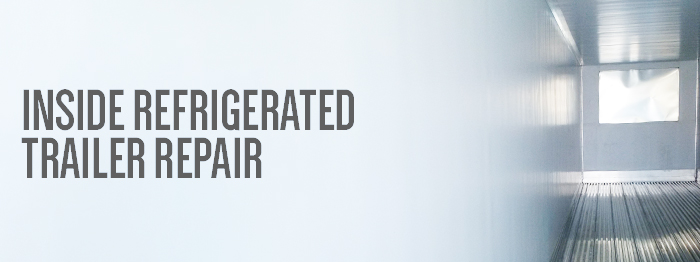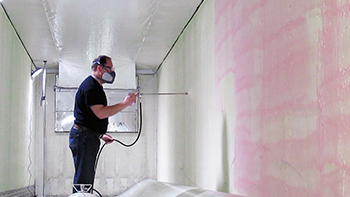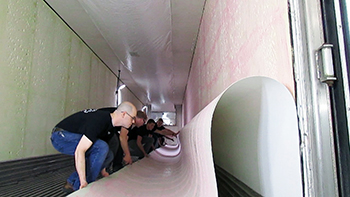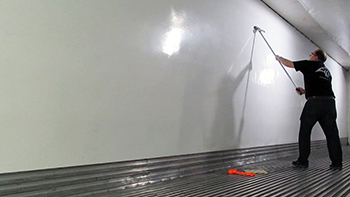
Driving down the interstate, we all notice (albeit sometimes subconsciously) those semis. What many of us don’t notice or think about is how many of them there are, and how many must need regular repair. There are over 500,000 refrigerated semi-trailers in the United States alone. Each one of these costs over $60,000 brand new and is expected to travel approximately one million miles in its lifetime (or about seven years of use). Maybe even more. That’s a lot of hours on the road – and a lot of shipments.
Think About It
Let’s think about this a little more. So if each one travels about a million miles, that must mean hundreds, possibly thousands of different loads of goods. And don’t tell me every forklift driver can drive flawlessly. There’s bound to be a few punctures and tears in the walls before long. And not just that, what about load shifting during transport? And surely there are some flawed trailers produced? What about moisture – surely that causes delamination in some cases? Yes to all of those. And these refrigerated units cost more to repair and maintain than a regular “dry box” trailer; aka “dry van”.
Repairs and Their Complexities
The repairs done to reefer trailers are typically split into two categories – those on the actual refrigeration unit, and those on the trailer itself. Often, a trailer repair facility will choose not to work on the reefer unit, but rather just on the trailer. Other refrigeration companies specialize in the technical repairs to those units.
The repairs to the trailer body internally are often on the walls, thanks to punctures, delamination and more. That where TensorGrip comes in. In the past years, repairs to the interior walls of reefers couldn’t possibly be done faster than 24 hours, and even that might be rushing it. This meant a lot of downtime and increased costs of repairs. Now, as long as the majority of the foam insulation is intact, a wall skin repair can be done in about an hour.
More Efficient Reefer Trailer Repair
Thanks to feedback from some of our earliest customers in this market, TensorGrip has been able to continually improve on the product offering. From its first product debut in trailer repair over 15 years ago, TensorGrip has morphed into a full system with a leading product which is takes about 45 minutes to repair a full wall and is much more pleasant to use.
At Quin Global, our team of innovators understand that limiting downtime – especially in the transport industry – is key to success. We also continue to strive for more eco-friendly solutions. That’s why our current TensorGrip EP0-CAL is both California VOC compliant and is less obnoxious smelling.
Keeping it Simple
So, you’re probably wondering how the time has been reduced from over 24 hours to less than an hour for a full-wall reefer trailer repair. Good question! In the past, repair shops used mastic adhesives (those in a caulk tube) which are slow to cure and require steady pressure over a period of time (usually 24-48 hours). This was traditionally done with load bars and 2x4s spread over the walls of the trailer. It wasn’t a perfect system and was awkward and dangerous. This method is known as blocking and bracing.
Since over 11 years ago, when we were approached by a frustrated prospect looking for a faster bonding solution, we’ve reduced this to a simple three-step approach after the initial stripping of the wall skin.
STEP 1: SPRAY
With the liner aligned to the wall and laying on the floor, spray both the wall and the liner with TensorGrip adhesive. That quick. That easy.
STEP 2: POSITION
When the adhesive is dry to the touch, you’ll need between three and ten people to work as a team and get the liner on the wall. The liner isn’t going to fall on you when you’re putting it on the wall! Once it’s on, it’s not going anywhere. Just take care to get it right the first time! No wasted time waiting for glue to cure – it takes just a few minutes for the adhesive to dry, then it will have full grab as soon as it comes in contact with the other substrate.
STEP 3: ROLL
You won’t need to block or brace, but you’ll still need to apply some pressure to get the maximum strength out of the TensorGrip repair. This is done with the EP0 Roller. Just push hard and roll the entire repaired area. This is what makes the repair so strong and successful. Fun fact – repairs made with TensorGrip to reefer trailers have been proven to be stronger than the original construction of the trailers as manufactured!
Final Thoughts
The entire process can be viewed in our demo video. In the future, we hope to be able to continue to add to the line of adhesives with additional benefits to the user. Contact us to get started with this powerful line of products!


